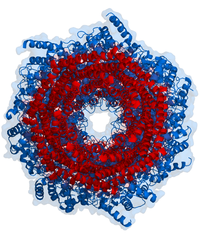
Photo from wikipedia
Many members of the tripartite motif (TRIM) family of ubiquitin ligases localize in spherical, membrane-free structures collectively referred to as cytoplasmic bodies (CBs) in a concentration-dependent manner. These CBs may… Click to show full abstract
Many members of the tripartite motif (TRIM) family of ubiquitin ligases localize in spherical, membrane-free structures collectively referred to as cytoplasmic bodies (CBs) in a concentration-dependent manner. These CBs may function as aggresome precursors or storage compartments that segregate potentially harmful excess TRIM molecules from the cytosolic milieu. However, the manner in which TRIM proteins accumulate into CBs is unclear. In the present study, using TRIM32, TRIM5α and TRIM63 as examples, we demonstrated that CBs are in a liquid droplet state, resulting from liquid-liquid phase separation (LLPS). This finding is based on criteria that defines phase-separated structures, such as recovery after photobleaching, sensitivity to hexanediol, and the ability to undergo fusion. CB droplets, which contain cyan fluorescent protein (CFP)-fused TRIM32, were purified from HEK293 cells using a fluorescence-activated cell sorter and analyzed by LC-MS/MS. We found that in addition to TRIM32, these droplets contain a variety of endogenous proteins and enzymes including ubiquitin. Localization of ubiquitin within CBs was further verified by fluorescence microscopy. We also found that the activation of the intracellular ubiquitination cascade promotes the assembly of TRIM32 molecules into CBs, whereas inhibition causes suppression. Regulation is dependent on the intrinsic E3 ligase activity of TRIM32. Similar regulation by ubiquitination on the TRIM assembly was also observed with TRIM5α and TRIM63. Our findings provide a novel mechanical basis for the organization of CBs that couples compartmentalization through LLPS with ubiquitination.
Journal Title: PLoS ONE
Year Published: 2022
Link to full text (if available)
Share on Social Media: Sign Up to like & get
recommendations!